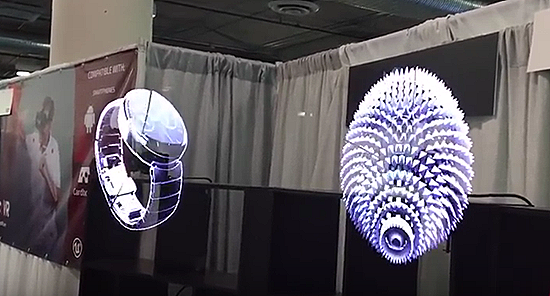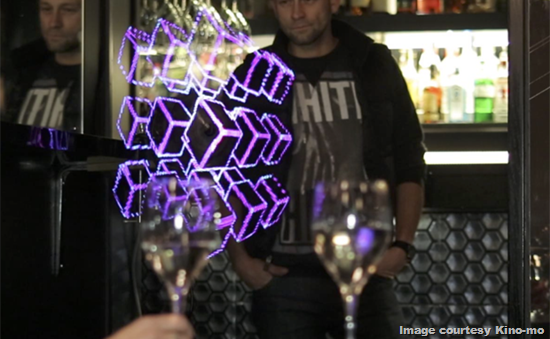
Looking to the future: 5 new ideas from CES 2016
By Barbara Krasnoff, Computerworld, 13 January 2016.
By Barbara Krasnoff, Computerworld, 13 January 2016.
Most of the vendors who exhibited at the CES trade show this year were showing off consumer products and technologies that are on the market or about to be. However, a number of smaller, often overlooked companies were exhibiting devices (and their underlying technology) that are are still in development - or just beginning to show their potential.
While these may not get the same media attention as the latest high-end TV or virtual-reality viewer, they can be as important - especially to businesses that might be able to make use of them, a few months or years down the line.
The products shown here are only a small handful of the hopefuls at CES. Without a crystal ball, it's impossible to say whether any will succeed or disappear in the huge number of competing ideas in today's tech market. But who knows?
1. Vayyar: See through walls without x-ray vision
If Jerry Siegel and Joe Shuster were creating their comic hero Superman today, they might not give him x-ray vision - instead, they would outfit the Man of Steel with Vayyar vision. Vayyar Imaging has developed a method of using radio frequency waves to penetrate everything from walls to human tissue; the waves bounce back and are interpreted by an array of sensors to create a graphic view of what lays inside.
The company was originally formed in 2011 to develop a medical tool that could search for breast tumours in a less expensive and less intrusive manner than current mammography machines. However, while the company has not abandoned its medical applications, it is also working on other uses - for example, creating a way for consumers to be able to pair one of its devices with a smartphone to find pipes and electric wiring in walls (as is pictured above).
Vayyar hopes to have a consumer version of its device ready sometime at the end of Q1 or the beginning of Q2 of this year. No price has yet been set.
2. Glowforge: Carve your pattern into any surface
3D printers are becoming almost ubiquitous, ranging from small, relatively inexpensive home devices to industrial units. Glowforge is a printer with a difference; it uses a CO2 laser that can, according to the company, cut and etch patterns into almost any type of material, from metal to leather to paper.
The device, which somewhat resembles an old-fashioned scanner, works in a variety of ways. You can send a design (created with any popular application or downloaded from the Glowforge library) to the laser via a Wi-Fi cloud connection; the laser will also follow a drawing placed on top of it. You then put your materials in a drawer at the bottom of the device; the system detects the type of materials and adjusts its cutting strength appropriately.
While Glowforge's website focuses on crafts and home uses, company reps stressed that the printer can also be used for business applications - for example, when engineers want to design a prototype of a part.
Glowforge is currently in pre-sale, at prices starting at US$2,395. The company expects to start shipping the device in the first half of 2016, at which time prices are expected to rise to a starting cost of US$4,000.
3. Kino-mo: A new kind of 3D image
Holograms have been around for decades now, but the limitations of the technology have made it impractical for anything but the occasional artistic project. A London-based company called Kino-mo has developed an LED-based technology that makes you think you're looking at a hologram - even if you're not.
The images - which float and move in the air like colourful, realistic ghosts - are produced with the use of projectors that use LEDs on spinning blades. These blades rotate at a speed that - according to Kiryl Chykeyuk, one of the founders - takes advantage of the "persistence of human vision," fooling the eye into thinking it's seeing an actual 3D image. He explained that one of the advantages of the technology is that it can use any software capable of creating a 3D image. And once created, those images can be up to three metres across.
Kino-mo has just begun manufacturing and is hoping to appeal to educators, companies looking for innovative types of advertising or organizations looking to enhance exhibitions, among others. Prices are available on inquiry.
4. NRG Go: Rent power for your smartphone
Anyone who lives by their smartphone knows how difficult it is to keep it powered throughout a day of calling, texting, researching, social networking, photographing and checking out the latest videos. NRG is a power company that serves customers across the U.S.; it has also built home and public charging stations for electric vehicles. Now it's trying to do the same for smartphones by developing a line of vending machines - called NRG Go Stations - that will provide portable chargers for consumers when and where they need it.
The project, which is currently being tested in Houston, works like this: A customer goes up to an NRG Go kiosk, puts in a credit card and pulls out a charger (which, according to a company rep, is good for two full smartphone charges). The charger is, in essence, rented for a day and costs US$3. The customer then returns it to any kiosk (or can mail it in). Every day that the charger is "rented" costs an extra US$3; after 7 days, the customer has, in essence, bought it and is charged for the remainder of the price (each charger costs US$45).
Will public power stations catch on? The concept is an interesting one, and NRG plans to broaden its network of kiosks in 2016.
5. CurveStar and SharkStream: The future of commercial photography?
It shouldn't be surprising that many innovative developments are coming out of universities - in fact, an entire section of Eureka Park, the part of CES dedicated to start-ups, showcased the work being done in academia. For example, the University of Southampton in the UK was showing two interesting tech projects: CurveStar, a way to light objects to be photographed efficiently and in great detail, and SharkStream, a way to achieve full-body motion capture wirelessly over long distances.
CurveStar (see the photo above) uses a collapsible geodesic lighting system to provide a flexible way to illuminate every facet of an object. According to a representative, the positioning and strength of the lighting can be controlled so precisely (using both the physical system and software) that small details, such as the texture of a piece of cloth, can be easily perceived.
Motion capture is the process of recording the movement of a human being (or other real object) for use in digital form, such as video games or movies. SharkStream, according to its developers, takes motion capture the next step, using two separate radio bands to allow the transmitters worn by the subject to send their data up to 250 metres away. This would allow motion capture software to, for example, follow an athlete running a track.
Both of these technologies are still in development.





No comments:
Post a Comment
Please adhere to proper blog etiquette when posting your comments. This blog owner will exercise his absolution discretion in allowing or rejecting any comments that are deemed seditious, defamatory, libelous, racist, vulgar, insulting, and other remarks that exhibit similar characteristics. If you insist on using anonymous comments, please write your name or other IDs at the end of your message.